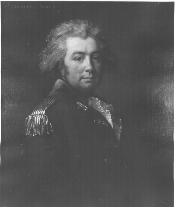Lieutenant-Governor
Simcoe: The
Man Who Planned
Yonge Street
 |
| John Graves
Simcoe, Lieutenant- Governor of Upper Canada, from a 1791 painting by
Jean Laurent Mosnier.
Metropolitan Toronto Reference Library |
John Graves
Simcoe was born at Cotterstock, Northamptonshire, England, in 1752, and
was educated at Eton and at Merton College, Oxford. He served with the British
Army through most of the American Revolution, commanding the
Queen's Rangers
from 1777 until he was invalided home in 1781. Elected to the British House of
Commons in 1790 for the constituency of St. Mawe's, Cornwall, he was appointed
the following year as the first lieutenant-governor of the new province of
Upper Canada.
Simcoe and his
wife, the gifted artist and diarist
Elizabeth
Posthuma Simcoe, arrived in Upper Canada in 1792. The governor chose
Newark (now Niagara-on-the-Lake) as his first capital, then in 1794 moved the
government offices to
York (now Toronto).
Simcoe's
progressive immigration schemes and road-building policies boosted the colony's
economic development, although his
Tory views on class privilege
and church-state relations contained the seeds for future discontent.
After leaving Upper Canada in 1796,
Simcoe served
as governor of the colony of San Domingo in the West Indies and as military
commander at Plymouth. He died at Exeter, England, in 1806, before he could
take up his appointment as military commander-in-chief in India.
|

